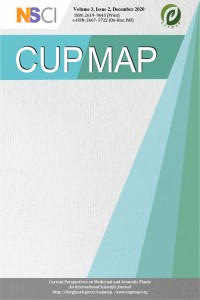Abstract
Pistacia terebinthus L., or turpentine tree, is a perennial flowering plant in the Mediterranean region, some aphids species induce the formation of galls in Pistacia terebinthus formerly called Carobs of Judea whose tannin content equals 60%, used in traditional medicine as a stimulant, diuretic, astringent for the treatment of asthma and other respiratory and urological affections,
In the present study, the antimitotic activity of Pistacia terebinthus galls was evaluated using meristematic cells of Allium cepa roots assay our results reveal that The methanolic extract decreased the root length and dividing cell number significantly after 96h and compared to control (p< 0.05) the mitotic index of extract at the concentration 4 mg/ml was 31% and has significant activity near to the standard methotrexate
Overall, the methanol extract of P. terebinthus galls revealed the presence of the phytochemical’s compounds such as gallic acid, caffeoylquinic acid, which affect plant mitosis and can be used as an antimitotic drug.
Supporting Institution
University Djilali Liabes UDL SIDI BEL ABBES
Project Number
UDL p7/2020
Thanks
The authors thank Pr Toumi, Dr Benouala for his assistance and all the members of pharmacognosy Laboratory. Thanks, are also due to Pr Diego cortes , Pr Alvarez R for there contribution and assistance.
References
- 1) NAZIM, B., HOUARI, T., & ISMAIL, B. Ethnobotanical Survey of Some Plants Used in Tessala Region, Algeria. Current Perspectives on Medicinal and Aromatic Plants (CUPMAP), 3(1), 18-24. 2) The Daphne Traditional Use and Biological Activities SA Bellifa Nazim, Benhaddou A, Toumi H, Achouri Y Eurasian Congress on Molecular Biotechnology, Trabzon, Turkey.2019 1 (978 …
Abstract
Project Number
UDL p7/2020
References
- 1) NAZIM, B., HOUARI, T., & ISMAIL, B. Ethnobotanical Survey of Some Plants Used in Tessala Region, Algeria. Current Perspectives on Medicinal and Aromatic Plants (CUPMAP), 3(1), 18-24. 2) The Daphne Traditional Use and Biological Activities SA Bellifa Nazim, Benhaddou A, Toumi H, Achouri Y Eurasian Congress on Molecular Biotechnology, Trabzon, Turkey.2019 1 (978 …
Details
| Primary Language | English |
|---|---|
| Subjects | Pharmacology and Pharmaceutical Sciences |
| Journal Section | Research Articles |
| Authors | |
| Project Number | UDL p7/2020 |
| Publication Date | December 24, 2020 |
| Published in Issue | Year 2020 Volume: 3 Issue: 2 |
-------------------------------------------------------------------------------------------------------------------------------













-------------------------------------------------------------------------------------------------------------------------
 CUPMAP Journal is licensed under a Creative Commons Attribution-NonCommercial-NoDerivatives 4.0 International License.
CUPMAP Journal is licensed under a Creative Commons Attribution-NonCommercial-NoDerivatives 4.0 International License.
-----------------------------------------------------------------------------------------------------------------------------------------
This is an open access journal which means that all content is freely available without charge to the user or his/her institution. Users are allowed to read, download, copy, distribute, print, search, or link to the full texts of the articles, or use them for any other lawful purpose, without asking prior permission from the publisher or the author. This is in accordance with the BOAI definition of open access.


